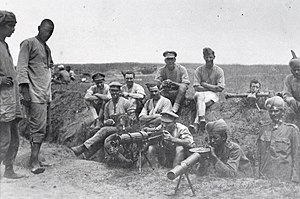
Back حملة بلاد الرافدين Arabic Campaña de Mesopotamia AST Mesopotamiya cəbhəsi Azerbaijani Месапатамская кампанія Byelorussian Teatre d'operacions de Mesopotàmia Catalan Mezopotámské tažení Czech Mesopotamienfront (Erster Weltkrieg) German Militkampanjo en Mezopotamio Esperanto Campaña de Mesopotamia Spanish Mesopotamiako kanpaina Basque
This article has multiple issues. Please help improve it or discuss these issues on the talk page. (Learn how and when to remove these messages)
|
| Mesopotamian campaign | |||||||||
|---|---|---|---|---|---|---|---|---|---|
| Part of the Middle Eastern theatre of World War I | |||||||||
 British and Indian machine gunners, Mesopotamia, 1917. | |||||||||
| |||||||||
| Belligerents | |||||||||
|
Jam'iya al-Nahda al-Islamiya (1918) | ||||||||
| Commanders and leaders | |||||||||
|
| |||||||||
| Strength | |||||||||
|
889,702 (total)[2] | c. 450,000[5][6] | ||||||||
| Casualties and losses | |||||||||
|
16,712 died of disease Total: 256,000 casualties |
Total: 325,000 casualties[8] | ||||||||
The Mesopotamian campaign or Mesopotamian front[9] (Turkish: Irak Cephesi) was a campaign in the Middle Eastern theatre of World War I fought between the Allies represented by the British Empire, troops from Britain, Australia and the vast majority from British Raj, against the Central Powers, mostly the Ottoman Empire. It started after British amphibious landings in 1914 which sought to protect Anglo-Persian oil fields in Khuzestan and the Shatt al-Arab. However, the front later evolved into a larger campaign that sought to capture the key city of Baghdad and divert Ottoman forces from other fronts. It ended with the Armistice of Mudros in 1918, leading to the cession of Iraq (then Mesopotamia) and further partition of the Ottoman Empire.
Fighting began after an amphibious landing by an Anglo-Indian division at the fortress of Al-Faw before rapidly advancing to the city of Basra to secure British oil fields in nearby Persia (now Iran). Following the landings, Allied forces won a string of victories along the Tigris and Euphrates Rivers, including repulsing an Ottoman attempt to retake Basra at the Battle of Shaiba. The advance stalled when the Allies reached the town of Kut south of the city of Baghdad in December 1915. At Kut, the Allied army was besieged and destroyed, later dubbed "the worst defeat of the Allies in World War I".[10] Following this defeat, the Allied army reorganized and began a new campaign to take Baghdad. Despite fierce Ottoman resistance, Baghdad was captured in March 1917 and the Ottomans suffered more defeats until the Armistice at Mudros.
The campaign ended with a British mandate over Mesopotamia being established and change of the power balance following the Ottoman expulsion from the region. In Turkey, elements of the last Ottoman parliament still claimed parts of modern-day Iraq such as Mosul as being Turkish, leading to Allied occupation of Constantinople. The British mandate over Mesopotamia later failed as a large-scale Iraqi revolt fueled by discontent with the British administration took place in 1920, leading to the Cairo Conference in 1921. There, it was decided a Hashemite kingdom under heavy British influence would be established in the region with Faisal as its first monarch.
- ^ Slot 2005, pp. 406–09
- ^ "British Army statistics of the Great War". Retrieved 30 November 2014.
- ^ Erickson 2007, page 154.
- ^ A naval history of World War I, Paul G. Halpern, Routledge, 1995, ISBN 1-85728-498-4, page 132.
- ^ Erickson 2001, p. 52: "the British ultimately sent almost double the number of men that the Turks did in that theater".
- ^ "Turkey in the First World War". turkeyswar.com. Retrieved 15 August 2016.
- ^ Smith and Mitchell, p. 224.
- ^ Mikaberidze 2011, p. 950.
- ^ "Mesopotamian Front | International Encyclopedia of the First World War (WW1)". encyclopedia.1914-1918-online.net. Retrieved 2023-09-24.
- ^ Christopher Catherwood (22 May 2014). The Battles of World War I. Allison & Busby. pp. 51–2. ISBN 978-0-7490-1502-2.